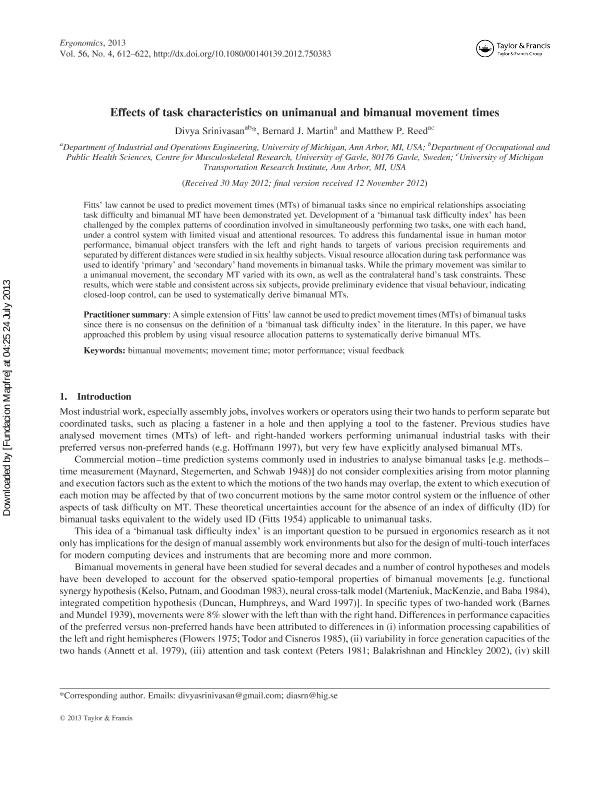Effects of task characteristics on unimanual and bimanual movement times

Contenido multimedia no disponible por derechos de autor o por acceso restringido. Contacte con la institución para más información.
| Tag | 1 | 2 | Valor |
|---|---|---|---|
| LDR | 00000cab a2200000 4500 | ||
| 001 | MAP20130022444 | ||
| 003 | MAP | ||
| 005 | 20130724153318.0 | ||
| 008 | 130724e20130401esp|||p |0|||b|spa d | ||
| 040 | $aMAP$bspa$dMAP | ||
| 084 | $a875 | ||
| 100 | 1 | $0MAPA20130009742$aSrinivasanab, Divya | |
| 245 | 1 | 0 | $aEffects of task characteristics on unimanual and bimanual movement times$cDivya Srinivasanab, Bernard J. Martina, Matthew P. Reed |
| 520 | $aFitts' law cannot be used to predict movement times (MTs) of bimanual tasks since no empirical relationships associating task difficulty and bimanual MT have been demonstrated yet. Development of a bimanual task difficulty index¿ has been challenged by the complex patterns of coordination involved in simultaneously performing two tasks, one with each hand, under a control system with limited visual and attentional resources. To address this fundamental issue in human motor performance, bimanual object transfers with the left and right hands to targets of various precision requirements and separated by different distances were studied in six healthy subjects. Visual resource allocation during task performance was used to identify primary¿ and secondary¿ hand movements in bimanual tasks. While the primary movement was similar to a unimanual movement, the secondary MT varied with its own, as well as the contralateral hand's task constraints. These results, which were stable and consistent across six subjects, provide preliminary evidence that visual behaviour, indicating closed-loop control, can be used to systematically derive bimanual MTs. | ||
| 700 | 1 | $0MAPA20130009759$aMartina, Bernard J. | |
| 700 | 1 | $0MAPA20100032114$aReed, Matthew P. | |
| 773 | 0 | $wMAP20100019818$tErgonomics : the international journal of research and practice in human factors and ergonomics$dOxon [United Kingdom] : Taylor & Francis, 2010-$x0014-0139$g01/04/2013 Volumen 56 Número 4 - abril 2013 , p. 612-622 |

